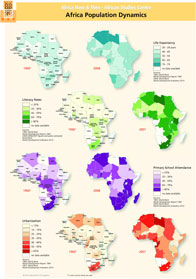Thematic Map: Africa Population Dynamics
 This thematic map gives insight into Africa's population dynamics between 1960 and fifty years later. Africa's population has grown extremely rapidly over the last fifty years: from 289 million inhabitants in 1961 to more than 1 billion today. This is a growth rate of 350% in just half a century. The number of urban residents has increased even more quickly: from 65 million in 1960 to 460 million today, or from 20% to 46% of the population as a whole. Demographers predict that soon more than 50% of all Africans will be living in cities.
This thematic map gives insight into Africa's population dynamics between 1960 and fifty years later. Africa's population has grown extremely rapidly over the last fifty years: from 289 million inhabitants in 1961 to more than 1 billion today. This is a growth rate of 350% in just half a century. The number of urban residents has increased even more quickly: from 65 million in 1960 to 460 million today, or from 20% to 46% of the population as a whole. Demographers predict that soon more than 50% of all Africans will be living in cities.
'Youth bulge'
The average life expectancy, literacy rates and primary-school attendance figures in Africa have also all increased spectacularly. Today there are large numbers of relatively healthy, well-educated young people with a more international view of the world. Changes in the structure of Africa's population are evident in the continent's population pyramid. A 'youth bulge' can be seen in Southern Africa's population statistics, with those aged between 10 and 30 far outnumbering those in the 0-10 age group and those over 30 years of age. In other parts of Africa, and for Africa as a whole, the population statistics still have a pyramid structure and have not yet created the sort of onion shape seen in Southern Africa.
Higher level of education
The expectation is, however, that a declining birth rate across Africa over the next few decades will lead to a change in the continent's population structure and there will be a relatively high number of 10-30 year olds compared to other parts of the world. The fact that there are so many youth in Africa today and that they are much better educated than their parents is having a big impact on the labour market. The youth are starting to feel disillusioned about the lack of job opportunities and are realizing that their (reasonably good) level of education is not going to allow them direct or easy access to greater prosperity and a better life.
Author(s) / editor(s)
How to order
The map can be ordered by sending an email to asc@ascleiden.nl, free of charge (only shipping costs).

